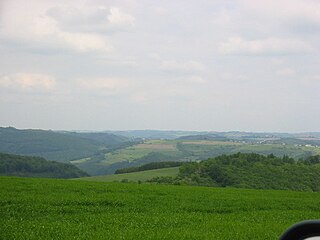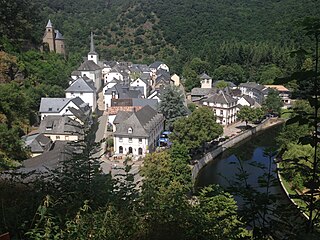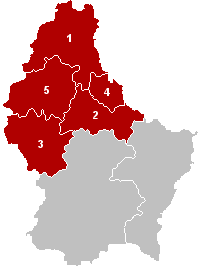The politics of Luxembourg takes place in a framework of a parliamentary representative democratic monarchy, whereby the Prime Minister of Luxembourg is the head of government, and the multi-party system. Executive power is under the constitution of 1868, as amended, exercised by the government, by the Grand Duke and the Council of Government (cabinet), which consists of a prime minister and several other ministers. Usually, the prime minister is the leader of the political party or coalition of parties having the most seats in parliament. Legislative power is vested in both the government and parliament. The judiciary is independent of the executive and the legislature.

The three districts of Luxembourg were the top-level administrative divisions of the Grand Duchy of Luxembourg. The districts were further subdivided into cantons, which still exist:

The District of Luxembourg was one of three districts of the Grand Duchy of Luxembourg. It contained four cantons, divided into 44 communes:
- Capellen
- Esch-sur-Alzette
- Luxembourg
- Mersch

The District of Grevenmacher was one of three districts of Luxembourg. It contained three cantons divided into 25 communes:
- Echternach
- Grevenmacher
- Remich

The Sauer or Sûre (French) is a river in Belgium, Luxembourg and Germany. A left tributary of the Moselle, its total length is 173 kilometres (107 mi).

Forêts[fɔ.ʁɛ] was a department of the French First Republic, and later the First French Empire, in present-day Belgium, Luxembourg, and Germany. Its name, meaning 'forests', comes from the Ardennes forests. It was formed on 24 October 1795, after the Southern Netherlands had been annexed by France on 1 October. Before annexation, the territory was part of the Duchy of Luxembourg and the Duchy of Bouillon. Its capital was Luxembourg City.

Diekirch is a canton in the north of Luxembourg. Its capital is Diekirch. Neither the canton, town, nor commune of Diekirch should be confused with the former district of Diekirch, one of three administrative units in Luxembourg abolished in October 2015.

Vianden is a commune with town status in the Oesling, north-eastern Luxembourg, with over 1,800 inhabitants. It is the capital of the canton of Vianden, which is part of the district of Diekirch. Vianden lies on the Our river, near the border between Luxembourg and Germany.

Vianden is a canton in the north of Luxembourg. Its capital is Vianden.

Luxembourg's 102 communes conform to LAU Level 2 and are the country's lowest administrative divisions.

The Islek (Aquilania) is a part of the German Eifel region (Rhineland-Palatinate), in the Bitburg-Prüm district next to the Luxembourg and Belgian border.

Esch-sur-Sûre is a commune and small town in north-western Luxembourg. It is part of the canton of Wiltz, which is part of the district of Diekirch. At one point it was the second smallest commune by area in Luxembourg, until Neunhausen and Heiderscheid were merged into it in 2011.

Circonscription Nord is an electoral constituency for Luxembourg's national legislature, the Chamber of Deputies. It includes the cantons of Clervaux, Diekirch, Redange, Vianden, and Wiltz, making it coterminous with the former district of Diekirch. As of 2005, Nord has an estimated population of 70,826, or 16% of Luxembourg's total population.
The Oesling or Ösling is a region covering the northern part of both the Grand Duchy of Luxembourg and Eifelkreis Bitburg-Prüm, within the greater Ardennes area that also covers parts of Belgium and France. The Oesling covers 32% of the territory of Luxembourg; to the south of the Oesling lies the Gutland, which covers the remaining 68% of the Grand Duchy as well as the southern part of the Eifelkreis Bitburg-Prüm.

A legislative circonscription is a multi-member electoral constituency that elects representatives ('deputies') to Luxembourg's unicameral national legislature, the Chamber of Deputies.

Tourism in Luxembourg is an important component of the national economy, representing about 8.3% of GDP in 2009 and employing some 25,000 people or 11.7% of the working population. Despite the 2008–2012 global recession, the Grand Duchy still welcomes over 900,000 visitors a year who spend an average of 2.5 nights in hotels, hostels or on camping sites. Business travel is flourishing representing 44% of overnight stays in the country and 60% in the capital, up 11% and 25% between 2009 and 2010. Published by the World Economic Forum in March 2011, the Travel and Tourism Competitiveness Report puts Luxembourg in 15th place worldwide, up from 23rd place in 2009.

The Eifel-Ardennes Green Route or Eifel-Ardennes Green Road is a cross-border, tourist route, about 500 kilometres long, which links the Ardennes to the Eifel. It runs from France via Belgium and Luxembourg to Germany mainly on quiet by-ways.
This page is based on this
Wikipedia article Text is available under the
CC BY-SA 4.0 license; additional terms may apply.
Images, videos and audio are available under their respective licenses.















